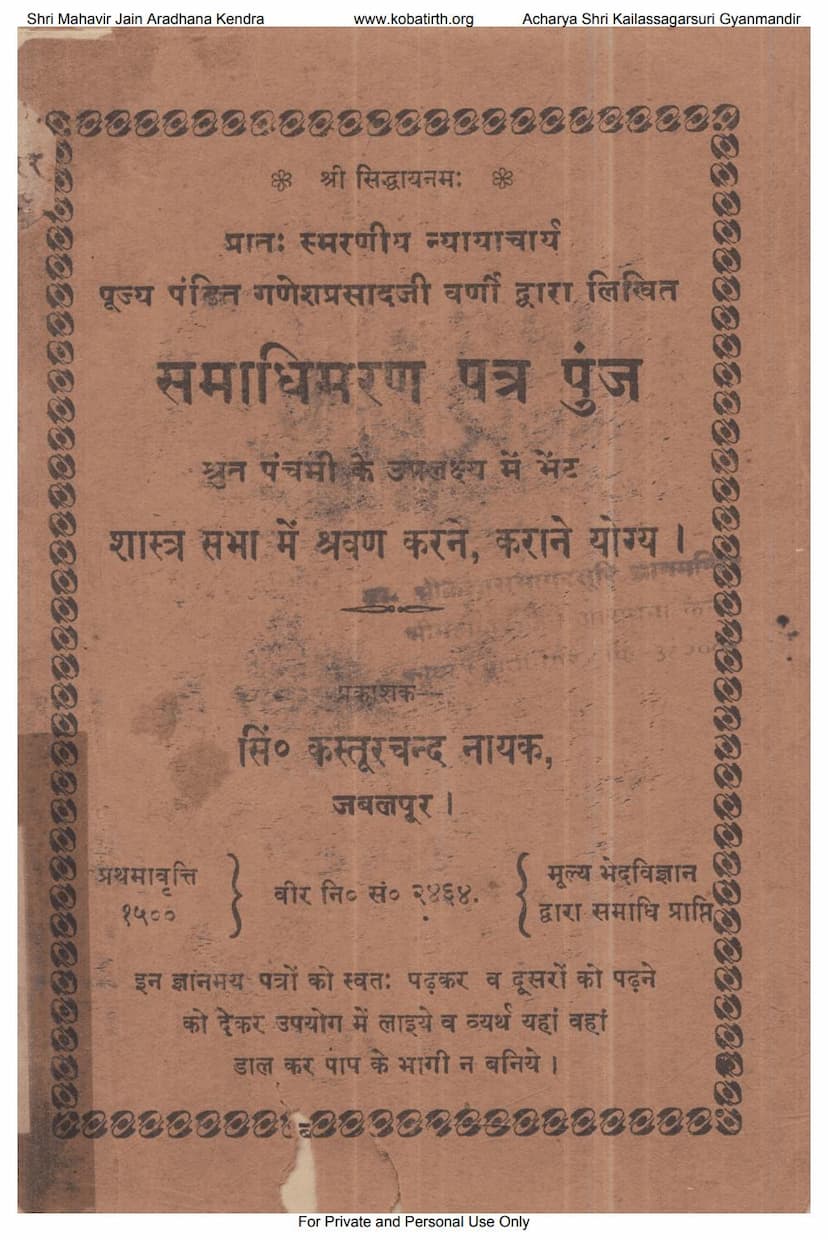Samadhi Maran Patra Punj
Added to library: September 2, 2025

Summary
Here's a comprehensive summary of the Jain text "Samadhi Maran Patra Punj" by Kasturchand Nayak, based on the provided pages:
Book Title: Samadhi Maran Patra Punj (A Collection of Letters on Samadhi Maran - Peaceful Death) Author: Pandit Ganeshprasadji Varni Publisher: Kasturchand Nayak Compiler/Publisher: Kasturchand Nayak, Jabalpur
Overall Theme:
The book is a collection of letters written by the revered Jain scholar Pandit Ganeshprasadji Varni to individuals seeking guidance on achieving a peaceful and conscious death (Samadhi Maran). It focuses on the principles of Jain philosophy, particularly Bhed Vigyan (discrimination between the self and non-self), detachment, right faith, knowledge, and conduct as pathways to spiritual liberation.
Key Concepts and Teachings:
The letters address various spiritual and philosophical points, offering guidance and encouragement to those facing terminal illness or contemplating the end of their lives. The central themes include:
- The Nature of the Self (Atma): The letters repeatedly emphasize that the true self is pure, conscious, and eternal, distinct from the physical body, senses, and all external possessions. The concept of "Ego me sasdato Aada Naan Dansan Lakshano" (I am one eternal soul characterized by knowledge and perception) is central.
- Bhed Vigyan (Discrimination): This is the cornerstone of the teachings. The reader is constantly reminded to discriminate between the soul and the non-soul (body, emotions, external objects). The letters explain that true understanding comes from recognizing that all things apart from the soul are "pardravya" (other substances) and not part of one's true being.
- Detachment and Non-Possession (Aparigraha): The letters stress the importance of non-attachment to the body, possessions, and worldly relationships. The concept of "Murchha" (attachment/clinging) is identified as a primary cause of suffering and bondage. The advice is to relinquish attachment, viewing them as transient and external.
- The Body as a Non-Self: The physical body, its ailments, and its eventual decay are consistently described as "pardravya." The focus should be on the well-being of the soul, not the body. The body is seen as a temporary vessel, and its changes should be observed with equanimity, as a witness.
- The Nature of Death (Maran): Death is not the annihilation of the soul, which is eternal. It is the separation of the soul from a particular body due to the exhaustion of lifespan. The fear of death stems from attachment to the body and worldly life. True knowledge dispels this fear.
- The Role of Faith, Knowledge, and Conduct (Darshan, Gyan, Charitra): These three jewels are presented as the path to liberation. Right faith in the true nature of the self, right knowledge of reality, and right conduct (which involves non-attachment and the eradication of passions) are essential for achieving Samadhi Maran.
- Conquering Passions (Kashayas): Anger, pride, deceit, and greed (krodh, maan, maya, lobh) are identified as the enemies of the soul. The letters urge the reader to strive for their reduction and ultimate elimination, leading to a state of equanimity (samata) and inner peace.
- The Importance of Internal Transformation: While external practices and observances are mentioned, the emphasis is overwhelmingly on internal transformation. The true spiritual path lies in the cultivation of inner qualities and the direct experience of the self.
- The Purpose of Scriptures: Scriptures like "Samadhi Shatak" and "Moksha Marg Prakash" are recommended for study, but the ultimate goal is not mere intellectual understanding but the practical application of these teachings in one's inner life.
- Samadhi Maran as a Goal: The entire collection of letters aims to guide individuals towards achieving Samadhi Maran – a state of peaceful, conscious, and detached passing from one life to the next, with the ultimate aim of liberation. This is achieved by keeping the mind focused on the self and devoid of worldly attachments and passions.
- The Publisher's Role: The preface and concluding remarks by Kasturchand Nayak highlight the importance of this knowledge for the welfare of all beings and express gratitude to those who contributed to its publication. He encourages readers to utilize the knowledge gained from these letters for their own benefit and spiritual progress.
Structure and Content:
The book contains a series of letters from Pandit Ganeshprasadji Varni to various individuals, including "Udasin Bra. Maujilalji Sagar" and "Udasin Bra. Deepchandji Varni." These letters offer personalized advice and spiritual guidance, addressing specific concerns and stages of spiritual development of the recipients.
The letters often begin with polite salutations and acknowledgments of the recipient's letters or situation. They then delve into the core Jain principles relevant to the context, using philosophical explanations, scriptural references, and analogies to illustrate the points.
Key Takeaways for the Reader:
- Focus on the Eternal Self: Do not be overly attached to the perishable body and its experiences.
- Practice Discrimination: Constantly differentiate between what is the self and what is not the self.
- Cultivate Detachment: Renounce all forms of attachment to external objects, relationships, and even one's own body.
- Control the Senses and Passions: Strive to minimize anger, pride, deceit, greed, and other negative emotions.
- Embrace Equanimity: Maintain a balanced and peaceful state of mind regardless of external circumstances or physical conditions.
- Seek Inner Knowledge: Focus on self-reflection and the study of scriptures to deepen understanding.
- Prepare for a Conscious Departure: By practicing these principles, one can achieve Samadhi Maran, a state of peaceful death that leads to a better destiny.
In essence, "Samadhi Maran Patra Punj" is a profound guide to spiritual living and dying, offering timeless wisdom from a great Jain scholar to navigate the challenges of life and attain ultimate liberation.